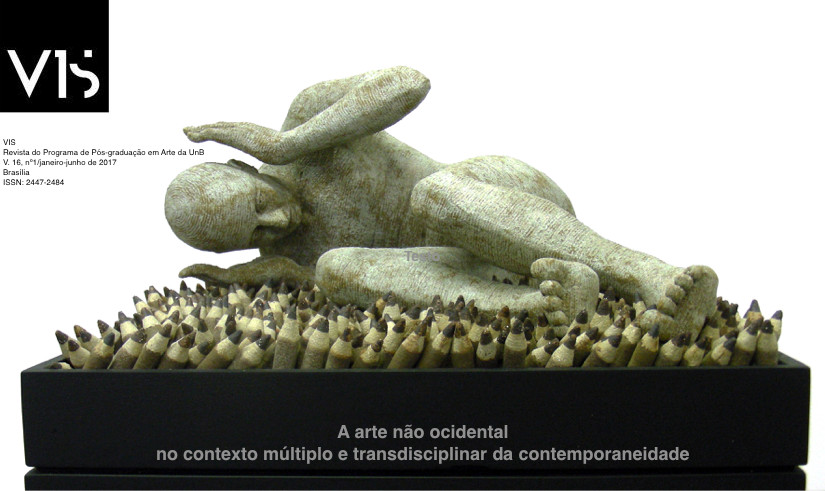Os 500 Arhats
o retorno de Murakami Takashi e a transformação da arte japonesa
DOI:
https://doi.org/10.26512/vis.v16i1.20486Palabras clave:
Arte. Japão. Tradição. Modernidade. Pós-Fukushima. Murakami Takashi.Resumen
Murakami Takashi é um dos mais celebrados artistas internacionais contemporâneos. As suas exposições, realizadas nos principais museus do mundo e em lugares famosos como o Rockfeller Center ou o Palácio de Versailles, têm atraído milhões de visitantes, alimentado a popularidade do artista e criado uma legião de admiradores dentro e fora do Japão. As obras de Murakami, cuja realização conta com o trabalho conjunto de centenas de pessoas, impressionam pelas dimensões, a qualidade e a utilização de mídias digitais. Por meio de sua arte, Murakami consegue fundir a iconografia tradicional com a dos mangás, e as tendências da cultura otaku com as influências estrangeiras na sociedade japonesa do pós-guerra. Em outubro de 2015, após 14 anos de ausência da cena artística do seu país, Murakami decidiu voltar a expor em Tokyo, no Museu Mori. O resultado foi a exposição The 500 Arhats, uma série de novos trabalhos que têm como tema a arte, a religião, a morte e as limitações humanas. O título da exposição refere-se, em particular, a uma pintura de 120 metros de comprimento (uma das maiores já realizada na história da arte mundial), que foi originalmente produzida para o Estado do Qatar como forma pessoal de agradecimento do artista pelo apoio financeiro que o Japão recebeu daquele país após o Tsunami de 2011. A proposta deste artigo é analisar o significado e a importância da exposição de Murakami no contexto cultural do Japão de hoje, e, ao mesmo tempo, visa refletir sobre seu papel de artista e sua complexa relação com alguns aspectos da tradição cultural japonesa.
Descargas
Citas
AZUMA, Hiroki. Generazione otaku: uno studio sulla postmodernità . Milano: Jaca Book, 2010.
_______________. Superflat Japanese Post-Modernity. 2001. Disponível em: <http://ha.shiftweb.net/en/texts/superflat_en1.html>. Acesso em: 05 nov.2012.
BENZON, William L. Godzilla’s children: Murakami takes Manhattan. Mechademia 2.1, p. 283-287, 2007.
BERQUE, Augustus. Identification of the self in relation to the environment. In: Nancy ROSENBERGER, Nancy (Org.). Japanese sense of self. Cambridge, New York, Melbourne: Cambridge University Press, 1994. p. 93-104.
BORNOFF, Nicholas. Sex and consumerism: the Japanese state of the arts. In: LLOYD, Fran (Org.). Consuming bodies: sex and contemporary Japanese art. London: Reaktion Books, 2002. p. 41-68.
BREHM, Margrit. The art in the floating world that almost was. In: BREHM, Margrit (Org.). The Japanese experience inevitable. Ostfildern: Hatje Cantz Publishers, 2003. p. 8-19.
CRUZ, Amanda. DOB in the land of otaku. In: CRUZ, Amanda; MATSUI, Midori ; FRIIS-HANSEN, Dana; MURAKAMI, Takashi (Orgs.). Takashi Murakami: the meaning of the nonsense of the meaning. New York: Harry N. Abrams, 1999. p. 14-19.
DARLING, Michael. Past + Present = Future. In: KIKI, Kaikai & MUSEUM OF CONTEMPORARY ART TOKYO (Orgs.). Takashi Murakami: summon monsters? open the door? heal? or die? Tokyo: Kaikai kiki Co. Ltd., 2001. p.64-71.
_______________. Plumbing the depths of Superflatness. Art Journal, v. 60, n. 3, p. 79-89, 2001.
FABBRI, Fabriano. Lo zen e il manga. Arte contemporânea giapponese. Milano: Bruno Mondadori, 2009.
FAVELL, Adrian. Before and after Superflat: a short history of Japanese contemporary art ”“ 1990-2011. Hong Kong: Blue Kingfisher limited, 2001.
FRIIS-HANSEN, Dana. The meaning of Murakami’s nonsense: about “Japan” itself. In: CRUZ, Amanda; MATSUI, Midori; FRIIS-HANSEN, Dana; MURAKAMI, Takashi (Orgs.). Takashi Murakami: the meaning of the nonsense of the meaning. New York: Harry N. Abrams, 1999. p. 30-41.
FURUKAWA, Hideo. Umatachi yo, soredemo hikari wa muku de. Tóquio: ShinchÅsha, 2011.
GEBHARDT, Lisette; MASAMI, Yuki. Literature and art after “Fukushima”. Berlin: Hubert & Co., 2014.
GIONI, Massimiliano. Takashi Murakami ”“ Ego Mix: some facts and fictions about the life and work of Takashi Murakami. In: TAKASHI, Murakami (Org.). Murakami: Ego. New York: Skira Rizzoli, 2012. p. 115-118.
GLUCK, Carol. The invention of Edo. In: VLASTOS, Stephen (Org.). Mirror of Modernity: invented traditions of Modern Japan. Berkeley: California University Press, 1998. p. 262-284.
GOMORASCA, Alessandro (Org.). La bambola e il robottone: culture pop nel Giappone contemporâneo. Torino: Einaudi, 2001.
HAROOTUNIAN, Harry. Visible discourses / invisible ideologies. In: MIYOSHI, Masao; HAROOTUNIAN, Harry (Orgs.). Postmodernism and Japan. Durham: Duke University Press, 1997. p. 63-92.
IWABUCHI, KoÌ„ichi. “Soft” nationalism and narcisism: Japanese popular culture goes global. Asian Studies Review, v. 26, n. 4, p. 447-469, dez. 2002.
KARATANI, Kōjin. One spirit, two nineteenth centuries. In: MASAO, Miyoshi; HAROOTUNIAN, Harry (Orgs.). Postmodernism and Japan. Durham: Duke University Press, 1989. p. 259-272.
KATO, ShÅ«ichi. Arte e Societá in Giappone. Torino: Edizioni dela Fondazione Agnelli, 1990.
KELTS, Roland. The Japanese soul. Nihilism and Revolution, Jul.-Aug., 2009.
KINSELLA, Sharon. Adult Manga: culture and power in contemporary Japanese society. Richmond Surrey: Curzon Press, 2000.
KOYAMA, Tomio. How to understand contemporary art. Art award Tokyo Marunouchi. 2010. Disponível em: <http://www.marunouchi.com/e/culture/art-award_10_07.html>. Acesso em: 25 mar. 2016.
LAMARRE, Thomas Mark. An introduction to Otaku Movement. Enter Text, v. 4, n. 1, 2004, p. 151-87.
LUBOW, Arthur. The Murakami method. 2005. The New York Times Magazine. Disponível em: <http://www.nytimes.com/2005/04/03/magazine/03MURAKAMI.html>. Acesso em: 13 fev. 2016.
MATSUI, Midori. Beyond the pleasure room to a chaotic street: transformations of cute subculture in the art of the Japanese nineties. In: MURAKAMI, Takashi (Org.). Little Boy: the arts of Japan’s exploding subculture. London: Yale University Press, 2005. p. 209-236.
_______________. Takashi Murakami: interview. Index Magazine. 1998. Disponível em: <http://www.indexmagazine.com/interviews/takashi_murakami.shtml>. Acesso em: 18 dez. 2016.
_______________. The Age of Micropop: the new generation of Japanese artists. Tokyo: Parco Co. Ltd., 2007.
_______________. Toward a definition of Tokyo Pop. In: CRUZ, Amanda; MATSUI, Midori; FRIIS-HANSEN, Dana; MURAKAMI, Takashi (Orgs.). Takashi Murakami: the meaning of the nonsense of the meaning. New York: Harry N. Abrams, 1999. p. 20-29.
MCGRAY, Douglas. Japan’s gross national cool. Foreign Policy, n. 130, maio-jun. 2002, p. 44-54. Disponível em: <http://www.foreignpolicy.com/articles/2002/05/01/japans_gross_national_cool?page=full>. Acesso em: 18 dez. 2016.
MIKI, Akiko. Takashi Murakami’s The 500 Arhats: return and rebirth. In: MURAKAMI, Takashi. Murakami Takashi ”“ The 500 Arhats. Tokyo: Mori Museum, 2016.
MIYAKE, Toshio, Occidentalismi. La narrativa storica giapponese, Venezia, Cafoscarina, 2010.
_______________. Mostri made in Japan: orientalismo e auto-orientalismo nell’era della globalizzazione. In: CASARI, Matteo (Org.). Culture del Giappone contemporaneo. Latina: Tunué, 2011. p. 165-197.
_______________. Occidentalismi: la narrativa storica giapponese. Venezia: Cafoscarina, 2010.
MÓ„RI, Yoshitaka. Subcultural unconsciousness in Japan: the war and Japanese Contemporary Artists. In: ALLEN, Matthew; SAKAMOTO, Rumi (Orgs.). Popular culture, globalization and Japan. New York: Routledge, 2006. p. 175-191.
MUNROE, Alexandra (Org.). Japanese after 1945: scream against the sky. New York: Harry N. Abrams, 1994.
_______________. Introducing Little Boy. In: MURAKAMI, Takashi (Org.). Little Boy: the arts of Japan’s exploding subculture. London: Yale University Press, 2005. p. 241-258.
_______________. Scream against the sky. In: MUNROE, Alexandra (Org.). Japanese after 1945: scream against the sky. New York: Harry N. Abrams, 1994. p. 19-24.
MURAKAMI, Takashi. A theory of Super Flat Japanese art. In: MURAKAMI, Takashi. Superflat. Tokyo: Madra, 2000. p. 15.
_______________. Earth in my window. In: MURAKAMI, Takashi (Org.). Little Boy: the arts of Japan’s exploding subculture. London: Yale University Press, 2005. p. 99-149.
_______________. Ego. New York: Skira Rizzoli, 2012.
_______________. Impotence culture ”“ Anime. In: MURAKAMI, Takashi. My reality ”“ contemporary art and the culture of Japanese animation. New York: Independent Curators International, 2001. p. 56-66.
_______________. Kaikai Kiki Company Ltd. Disponível em: . Acesso em: 18 dez. 2016.
_______________. Life as a Creator. In: KAIKAI KIKI & MUSEUM OF CONTEMPORARY ART TOKYO (Orgs.). Takashi Murakami: summon monsters? Open the door? Heal? Or die? Tokyo: Kaikai Kiki Co. Ltd., 2001. p. 130-147.
_______________. Murakami Takashi ”“ The 500 Arhats. Tokyo: Mori Museum, 2016.
_______________. Superflat trilogy: greetings, you are alive. In: MURAKAMI, Takashi (Org.). Little Boy: the arts of Japan’s exploding subculture. London: Yale University Press, 2005. p. 151-161.
_______________. Superflat. Tokyo: Madra, 2000.
_______________. The Super Flat Manifesto. Super Flat. Tokyo: Madra, 2000.
MURAYARI, Gary-Carrion. Takashi Murakami ”“ The 500 Arhats. In: MURAKAMI, Takashi (Org.). Ego. New York: Skira Rizzoli, 2012. p. 119-122.
NAPIER, Susan. Anime from Akira to Princess Mononoke: experiencing contemporary Japanese animation. New York: Palgrave, 2001.
NATILI, Donatella. WagÅ RyÅ«ichi. Revista Brasileira, Academia Brasileira de Letras, Fase VIII, ano v, n. 87, p. 247-261, abril-maio-junho 2016. Disponível em:<http://www.academia.org.br/sites/default/files/publicacoes/arquivos/revista_brasileira_87. pdf>. Acesso em: 28 fev. 2017.
OKADA, Toshio; MORIKAWA, KaichiroÌ„; MURAKAMI, Takashi. Otaku Talk. In: MURAKAMI, Takashi (Org.). Little Boy: the arts of Japan’s exploding subculture. London: Yale University Press, 2005. p. 164-185.
PEREZ, Magdalene. Artinfo. 7 mar. 2007. Disponível em: <http://www.artinfo.com/news/story/17056/takashi- murakami>. Acesso em: 18 dez. 2016.
ROSENFIELD, John M.; CRANSTON, Fumiko E.; RICHARD, Naomi Noble. Extraordinary persons, Kinsei kijin no geijutsu: works by eccentric,nonconformist Japanese artists of the early modern era (1580-1868) in the collection of Kimiko and John Powers. Cambridge: Harvard University Art Museums, 1999.
ROSENFIELD, John M.; CRANSTON, Fumiko E.; RICHARD, Naomi Noble; SALTZ, Jerry. Imitation Warhol. The Village Voice, 24 ago. 1999. Disponível em: <http://www.villagevoice.com/1999-08-24/art/imitationwarhol/>. Acesso em: 20 mar. 2016.
SAWARAGI, Noi. Nihon - Gendai - Bijutsu. Tokyo: Shinchosha, 1998.
_______________. On the battlefield of “Superflat”: subculture and art in postwar Japan. In: MURAKAMI, Takashi (Org.). Little Boy: the arts of Japan’s exploding subculture. London: Yale University Press, 2005. p. 187-205.
SIEGEL, Katy. In the air. In: MURAKAMI, Takashi (Org.). Little Boy: the arts of Japan’s exploding subculture. London: Yale University Press, 2005. p. 269-287.
STEINBERG, Marc. Emerging from Flatness: Murakami Takashi and Superflat aesthetics. 2002. 231 f. Dissertation (Master in Arts) ”“ Faculty of Graduate Studies and Research, East Asian Studies Department, McGill University, Montreal, 2002.
_______________. Otaku consumption, Superflat art and the return to Edo. Japan Forum, v. 16, n. 3, p. 449-471, 2004.
TSUJI, Nobuo. Lineage of Eccentrics. Tokyo: Kaikai Kiki, 2012.
_______________. The playfulness in Japanese art. Lawrence, Kansas: Spencer Museum of Art; The University of Kansas, 1986.
UENO, Toshiya. Japanimation and Techno-Orientalism. Disponível em: <http://www.t0.or.at/ueno/japan.htm>. Acesso em: 13 mar. 2016.
VOGEL, Carol. The Warhol of Japan pours ritual tea in a Zen moment. The New York Times Magazine, 7 maio 2007. Disponível em: <http://www.nytimes.com/2007/05/07/arts/design/07mura.html?n=Top%2fReference%2fTimes%20Topics%2fPeople%2fM%2fMurakami%2c%20Takashi&_r=0>. Acesso em: 5 maio 2016.
WAKASA, Mako. Takashi Murakami (interview). Journal of Contemporary Art, 24 fev. 2000. Disponível em: <http://www.jcaonline.com/murakami.html>. Acesso em: 18 dez. 2016.
WEISENFELD, Gennifer. Rescribing Tradition in a Transnational Art World, Transcultural Studies, 2010.
YODA, Tomiko. A roadmap to Millennial Japan. The South Atlantic Quarterly, v. 99, n. 4, p. 629-668, 2000.




